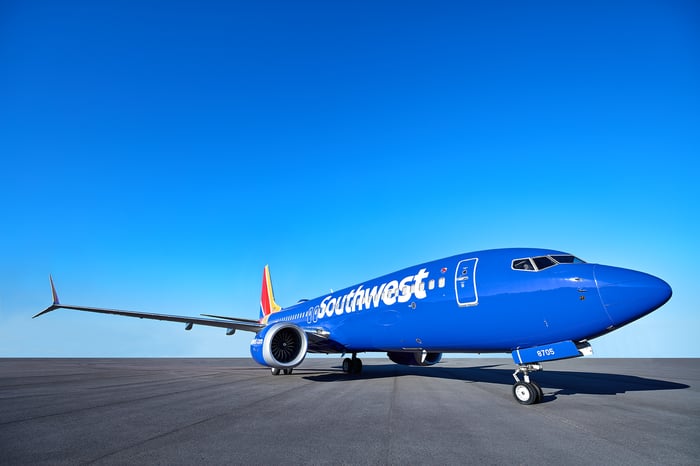Over the past decade, Alaska Air (ALK -1.89%) has become one of the leading carriers in the West Coast-Hawaii travel market. Today, it serves more than two dozen routes to Hawaii. These flights have been extremely successful for Alaska Airlines.
However, competition has been heating up on mainland-to-Hawaii routes. United Airlines and Hawaiian Holdings (HA -3.72%) -- the top two carriers in the market -- have significantly increased their Hawaii flight schedules since late 2017. Most notably, popular low-fare carrier Southwest Airlines (LUV -0.54%) began flying to Hawaii earlier this year.
Following a long delay caused by the grounding of the Boeing 737 MAX, Southwest is gearing up to add more flights to Hawaii soon. With Alaska's financial performance on Hawaii routes already suffering, this could force the Seattle-based airline to start cutting back in the Hawaii market.
West Coast-Hawaii capacity growth is accelerating again
In 2018, total airline industry seat capacity between the western U.S. and Hawaii surged 10.7% year over year. Not surprisingly, this put pressure on airfares.

A surge in capacity has hurt pricing on West Coast-Hawaii flights. Image source: Alaska Airlines.
Growth slowed in the first quarter of 2019 -- with total seats between the western U.S. and Hawaii rising just 1% -- as airlines began to lap their capacity increases from the previous year. However, Southwest launched its first Hawaii route in mid-March, and its expansion in the following months caused industry capacity growth to accelerate once again.
In June, the first full month of Southwest Airlines operating all of the flights it has announced thus far, capacity rose 8.2% between the West Coast and Hawaii. Industry capacity to Hawaii surged 68% in Oakland and 19% in San Jose. Those two cities -- Southwest's current gateways for Hawaii flights -- accounted for about half of the increase in seats to Hawaii. There were also double-digit capacity increases in Denver, Sacramento, and Seattle, as other carriers, including Alaska, continued to add flights to the Hawaiian Islands.
Alaska Airlines is feeling the effects
Even in the first quarter, when West Coast-Hawaii industry capacity barely grew, Alaska Airlines experienced weak pricing on many Hawaii routes. While the second quarter is a seasonally stronger period -- and benefited from the timing of Easter this year -- Alaska's management reported further "softness in Hawaii pricing" due to overcapacity in the market. It expects the pressure to continue in the third quarter.
Alaska Airlines' rollout of "Saver" fares -- its version of the barebones basic economy fares that have become ubiquitous in the U.S. recently -- has helped it offset some of the pressure from weak pricing in Hawaii. However, Alaska has now completed the rollout of saver fares, so that initiative will produce few if any incremental revenue benefits in the future. Meanwhile, industry overcapacity is about to get worse.
Southwest Airlines isn't waiting for the MAX
When Southwest put its first Hawaii routes on sale back in early March, it said that additional flights to Hawaii from Sacramento and San Diego -- as well as service to Lihue -- would "be announced in the coming weeks." Before that could happen, though, the carrier's 737 MAX fleet was grounded, leaving it short of aircraft and unable to introduce new routes.
In conjunction with its Q2 earnings report last month, Southwest Airlines declared that it no longer plans to wait for the 737 MAX to resume expanding in Hawaii. The carrier will end all service to Newark, New Jersey in early November, freeing up capacity for additional Hawaii flights. As a result, Southwest plans to announce its first routes from Sacramento and San Diego to Hawaii in the near future. The flights could begin as soon as November.
Additional service from Oakland and San Jose to Hawaii is likely, too. Those flights could begin either in late 2019 or early in 2020.

Southwest will resume its growth in Hawaii soon, even without the 737 MAX. Image source: Southwest Airlines.
Something's got to give
The upshot of Southwest Airlines' plan is that overcapacity on West Coast-Hawaii routes will get worse over the next few quarters, not better. Furthermore, Southwest's four gateway cities for Hawaii service account for about a third of Alaska Airlines' flights to Hawaii.
Alaska Airlines posted a strong 5.2% unit revenue gain last quarter, but that was in spite of rather than because of its Hawaii routes. Moreover, it is currently on track to post a full-year adjusted pre-tax margin of roughly 11%, falling short of its 13% to 15% long-term target range. As a result, Alaska Airlines can't afford to maintain the status quo in Hawaii if it means that unit revenue and profitability on those routes will continue to deteriorate.
Alaska also can't count on Hawaiian Airlines cutting back on routes to Hawaii from Oakland, Sacramento, San Diego, and San Jose. For one thing, those routes are of far greater strategic importance for Hawaiian than they are for Alaska Airlines. Additionally, Hawaiian Airlines uses ultra-efficient Airbus A321neo jets on those routes, giving it a unit cost advantage.
If Southwest Airlines aggressively ramps up its Hawaii service as planned, Alaska Airlines may find itself with no good alternatives to reducing service in the markets that Southwest is entering. The good news is that this will free up aircraft for Alaska Airlines to continue expanding in its top markets of Seattle and Portland. Alaska has a bigger competitive advantage in those places, which could enable it to generate higher margins there in the long run.



